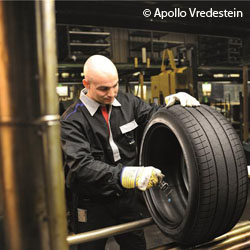Latex hunt produces key results in Europe
The Dutch tyre company Apollo Vredestein has successfully produced the first prototypes of tyres obtained from natural latex from guayule and Russian dandelion plants. An outcome of the EU-PEARLS ('EU-based production and exploitation of alternative rubber and latex sources') project, the prototypes will be tested before their production is initiated. The researchers say these tyres could find a solid niche in the global market, helping Europe compete against Asian rubber manufacturers. EU-PEARLS received almost EUR 5.9 million under the 'Food, agriculture and fisheries, and biotechnology' (KBBE) Theme of the EU's Seventh Framework Programme (FP7). EU-PEARLS investigated potential alternative sources of latex and rubber in order to give Europeans a means to depend less on Asian products and to give Europe-based latex-producing facilities a boost. For its part, project partner NEIKER-Tecnalia from Spain analysed the genotyping of guayule (Parthenium argentatum) and the Russian dandelion plants (Taraxacum koksaghyz), two species used for substituting imported natural latex and their possible introduction into Europe. The researchers believe guayule can be grown in the Mediterranean area successfully and the Russian dandelion is better suited for eastern and northern countries in Europe. Experts say various natural latexes are key for natural rubber extraction. Natural rubber is a raw material used for the production of tyres, footwear, adhesives, surgical gloves and condoms. But Europeans currently import all of the latex used in the region; this latex is derived from the rubber tree Hevea brasiliensis. The top global producers of this latex are Indonesia, Malaysia and Thailand. Despite their efforts, to date researchers have struggled to find a suitable substitute for natural rubber, but thanks to the EU-PEARLS project at last an alternative is here. Finding an alternative will help avoid a coordinated increase in the price of this raw material. Both guayule and the Russian dandelion are solid alternatives. Experts have already started using guayule to produce biomass on a large scale in Spain. It should be noted that extraction of the Russian dandelion seems to be easier. The consortium optimised the development and acceleration of the growth of the Russian dandelion to boost its content of natural rubber available for extraction. Finding a solution is important because not only is Europe forced to import the material but the Hevea brasiliensis tree is facing various threats. Both pests and diseases are affecting this tree. Its cultivation is also associated with very specific climate conditions that exist primarily in Asian and South American tropical zones. Researchers also recognise that the rubber from this tree triggers a latex allergy that is prevented with the use of guayule and Russian dandelion latex. EU-PEARLS project partners were from the Czech Republic, France, Germany, Kazakhstan, the Netherlands, Spain, Switzerland and the United States.For more information, please visit: EU-PEARLS http://www.eu-pearls.eu/UK/(opens in new window)
Countries
Switzerland, Czechia, Germany, Spain, France, Kazakhstan, Netherlands, United States



